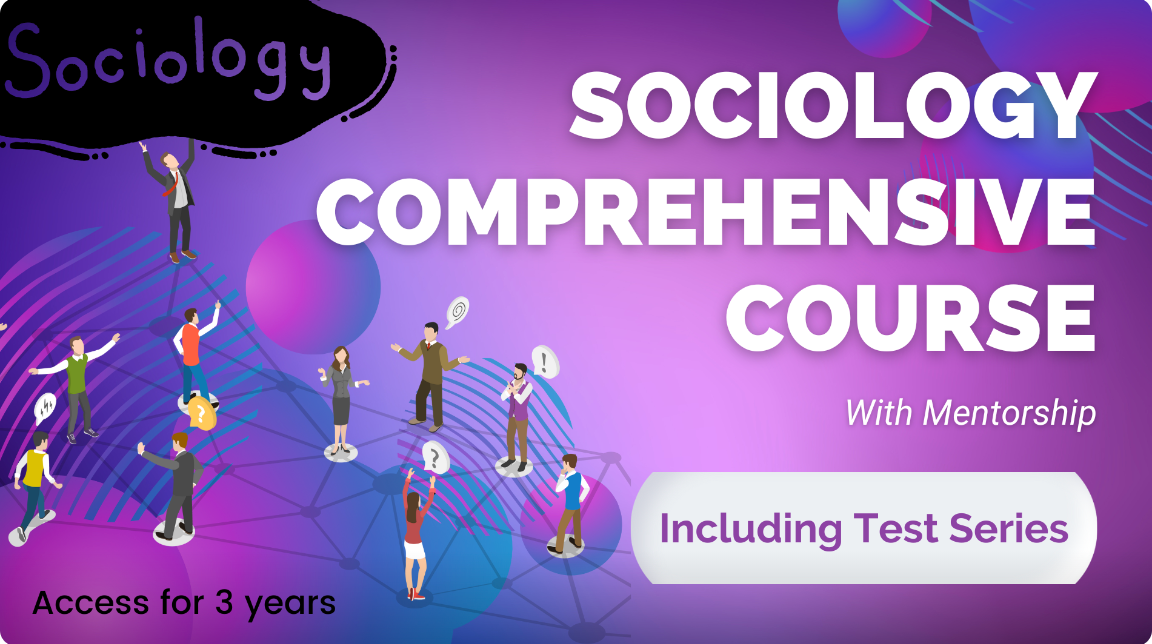Questions
- Examine gender, ethnicity and race as major dimensions of social stratification. (20 Marks)
- Education is often viewed as an agency of social change. However, in reality, it could also reinforce inequalities and Conservatism. Discuss. (20 Marks)
Download Model Structures PDF
Model Structures
Q1. Examine gender, ethnicity and race as major dimensions of social stratification. (20 Marks)
Introduction
- Social stratification is a kind of social differentiation whereby a society groups people into socio-economic strata, based upon their occupation and income, wealth and social status, or derived power.
Main Body
- Gender, Ethnicity and Race are the three major dimensions of Social Stratification. It is explained one by one in the following section:
Social Stratification of Gender
- Gender is one of the most elementary forms of stratification.
- Functionalists like Mudrock and Parsons considered this as natural. They believed that men are the breadwinners and women are expected to take the household chores.
- This natural role thesis has come under attack as the traditional patriarchal division of labour is being slowly turned on its head.
- Women are attached to two fold stratification i.e. relation to men and relation to other women.
- The unequal access to resources, opportunities and rewards are legitimised by patriarchy and reinforced through its institutions.
- Marxist school of thought sees female subordination as a result of private property and consequent adoption of monogamy.
- Blackburn and Stewart explain that women going to work itself doesn’t ensure gender equality because women are often employed in part-time and low paid jobs. Occupational segregation reinforces stratification in society.
- Feminist scholars, such as Joan Acker, have criticized “traditional” stratification research, which has mostly ignored gender altogether
Social Stratification of Race
- Race as a biological concept refers to a large category of people who share certain inherited physical characteristics like colour of skin, type of hair, facial features and size of head.
- Sociologists view race as merely an ideological construct based on physical differences.
- It was also used as a tool of domination, discrimination and spreading inequality in the form of racial stratification.
- Joseph Arthur De Gobineau in the middle of 19th century gave the first major racial classification in terms of three distinct groups which were White (Caucasian), Black (Negroid) and Yellow (Mongolian).He also attached notions of superiority and inferiority with these races.
- Use of exclusionary methods like ghettos, intermarriage restrictions and social distance maintenance gives a practical shape to ethnocentrism.
- From conflict perspective, racial stratification is seen as a product of the capitalist system in which ruling class used slavery, colonization and racism as tools for exploiting labor.
- Rudyard Kipling's White Man’s Burden theory.
Social stratification of Ethnicity
- While race is perceived as biological, ethnicity is purely cultural or social in its meaning.
- An ethnic group may have a common language, history, national origin or lifestyle.
- Balkanization of Europe, conflicts in Africa, tribal rivalries of the Indian sub continent are attributed to ethnic problems.
- Paul Brass (1991) discusses three ways of classifying ethnic groups: a) in terms of objective attributes, b) by reference to subjective feelings and c) in relation to behaviour.
- Writers like Glazer (1975) have contended that not only does ethnic feelings cease to exist in a modern society, but is actually ‘revived’ and what is more is that increasing
- The importance of ethnic identities or ethnicization can be attributed to the rising conditions of modernization.
- Ethnicity is a search for an identity by a group and a demand that this identity be publicly acknowledged.
- However, it also has a practical aim for that group, namely, the demand for progress, for a rising standard of living, for a more effective political order and greater social justice.
Conclusion
- Some theorists have argued that with time the intensity of stratification will weaken and on the other side few have shed light on the functionality of stratification. A balance has to be reached so that stratification does not endanger individual selfhood and national integrity and, in turn, individualism and nationalism do not pose a threat to individual identities.
Q2. Education is often viewed as an agency of social change. However, in reality, it could also reinforce inequalities and Conservatism. Discuss. (20 Marks)
Introduction
- Social change is defined as a change in values, ideology, institution, structure, human interactions and interrelations in a society.
Main Body
- Education is the most powerful instrument of social change. It is through education that society can bring desirable changes and modernize itself.
- Education can transform society by providing opportunities and experiences through which the individual can cultivate him/herself for adjustment with the emerging needs and philosophy of the changing society.
- Education as a factor of social change is discussed by the various schools of thoughts.
- Functionalists like Durkheim and Talcott Parsons established a positive relationship between education and social change.
- While Durkheim argued that education prepared students for taking up a future role in capitalist society, Parsons advocated that schools in capitalist America offer adequate training to the children to get into the job market.
- Davis and Moore in their theory of stratification advocated that highly specialized persons get high degrees of specialization and are endowed with exclusive qualities to fit into the highly challenging and most productive occupations. They are instrumental in the economic progress and social development of the nation. As a result, the values like self-orientation, individualism, achievement, competition, universalism, innovation, conformity to legal provisions of society and equality has predominated the thought of every generation.
- However, Education also reinforces inequalities and conservatism.
- Pierre Bourdieu, in his theory of social & cultural reproduction says that education preaches equality but practises reinforcement of hierarchy & inequality.
- The children belonging to an upper class having control over economic, cultural and social capital enter into high profitable occupations and this success is legitimized by the school.
- Education offers no scope for mobility and mass education is given to masses but exclusive education important for the job market is monopolized by the upper class.
- The argument of Bourdieu is supported by Bowels and Gintis who advocated that schools in capitalist America are class-based rather than egalitarian. It provides the least opportunity for mobility. The children belonging to lower class get into low privilege schools and subsequently get into low paid jobs.
- Andre Beteille in his article advocates that it is not the principle of equality or economic interest or search for mobility that put people into schools rather entry into school and success into school is greatly defined by family, kinship, religion or other cultural variables. The role of education in encompassing mobility cannot be universally similar. In every society, various forms of compulsions, institutional conditions, and value systems will determine to what extent, in what forms education has successfully contributed to mobility.
- Pierre Bourdieu, in his theory of social & cultural reproduction says that education preaches equality but practises reinforcement of hierarchy & inequality.

